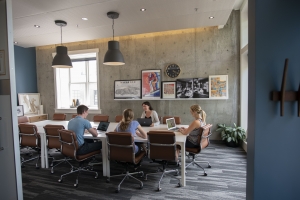How to Pick and Set Your 2020 Goals
The new year is in just a couple of days, and it is important to begin reflecting on your 2020 and what you want to accomplish in the new year.
Laura Winter, with Medium, offers some ways to help you reflect on the past year and set your goals for the new year that align with your values:
Reflect on Your Accomplishments
“Think back to all of the things you accomplished during the year, anything you appreciate, and some place where you made great strides. Can you improve on any of these items? Are there goals you can set to keep these accomplishments at the forefront?”
Reflect on Your Setbacks
“It’s important to remember that we can learn more from our mistakes than our successes, but that doesn’t make us a failure. Where are places that you maybe didn’t accomplish what you wanted? What changes can you make in those areas to better your chances for success?”
Reflect on Your Habits
“Think about the habits you adopted that you are thankful for. Maybe you stopped drinking or smoking. Maybe you picked up an exercise habit. Think about how you can keep these going into the new year, or even challenge yourself to go the next step.
Even think about the habits you developed that you aren’t quite proud of. Maybe you started staying up later and suffered in the morning. Maybe you picked up one too many streaming services and can’t seem to get away from the TV. See if there are adjustments you can make to your habits as the new year begins.”
Set a Focus
“Now that you’ve reflected, set your focus on the things that you believe will make the biggest change in your life. Have a clear definition of what this change will be and be laser-focused. Make it the center of your attention.
For example, I am going to spend 2020 focused on the overarching goal of writing. That means any tasks that interfere with my one goal will inevitably be put in the back of my queue. My priority is making writing happen, and aligning my life to support that goal.”
Set an Intention
“Now that you have something to focus on, do a deep dive into it. Plan out how you are going to make that change happen. Schedule it into your day. Declare your why, or the big reason you want that change to happen.
Think back to my writing goal, which I now set my intentions. That plan, broken apart, includes changing some behaviors (like hitting snooze or not carrying a notebook around) as well as setting intentions and schedules during my day specifically around writing. It also includes projects such as book writing and editing as well as blogging and marketing more. I’ve even created an editorial calendar (part of my starting 2020 resolutions now) to give me a head start once January 1 arrives.”
Set a Structure
“I touched briefly on this above, but create a structure for which your goal can flourish. That might mean scheduling it into your day, creating a routine around it, setting reminders, changing your environment, or joining a community of support. All of these things can create accountability, either to yourself or to others. While you can have rewards around your goal, hopefully your time and dedication will reap benefits for you as well.
Sometimes we can’t always rely on motivation to keep us going. There are going to be days where we want to do anything but our goal. Obviously, healthy breaks can help us come back refreshed and ready to attack our goals, but creating a routine or ritual around your goal can be huge toward progress.”
Reflect on Your Intentions
“Just one review at the end of the year is not enough. Build monthly or weekly reviews into your schedule. Determine what is working and what isn’t working and make the necessary adjustments. Regular check-ins can help you stick to your new goals and habits and help you succeed in the long run.”
Grow a Business with Us!
With many benefits to using a coworking space, the #1 benefit may be how it benefits your business's bottom line. In an article on CoworkingResources.com, the author lists four economic benefits of coworking spaces.
Coworking Supports Creatives
Coworking spaces provide a place for small businesses to thrive. The coworking spaces are cheaper than renting a private office to the companies in their beginning stages. Those small businesses bolster creative spirit in local communities and increase employment opportunities, which in the end puts money back into their communities / local economy.
Eliminated Financial Obstacles
As mentioned above, coworking spaces tend to be less expensive than traditional private offices. Small businesses, or people who want to start a business, are often discouraged by the overwhelming overhead costs. Coworking provides the flexibility, in packages and amenities, that these businesses need to flourish.
Retains Local Talent
Coworking spaces keep the innovative, entrepreneurial talent in the community. Rather than heading towards a bigger city, the talent can stay in their place of origin or desire.
“Without coworking offices, many of these daring creatives who possess the wherewithal to start their own ventures would have to relocate to bigger cities where their skills and passions would be diluted by a larger population.”
These innovative and entrepreneurial people and businesses can stay in their local communities to pursue their passion.
Employs Small Businesses
Coworking spaces often hire local restaurants and coffee shops to supply their spaces with all the coffee and food it needs. Some coworking spaces have even been able to exchange coffee for interior design or legal services to the coffee shops, by involving the people working in the space.
“Coworking spaces attract the kind of trustworthy, selfless person that can help collaborative consumption succeed. In a coworking environment, the sharing takes place on a more personal level than in any other kind of work environment, which helps the people in this environment see that there are countless more opportunities available to them when resources are shared. By fostering connection and collaboration, coworking spaces help people gain new skills, save money, and see the world in a brighter light, one that attaches importance to everyone’s contributions.”
How To Create Your Perfect Productivity Schedule
Has anyone ever told you to have a chock-full morning routine in order to "face the day" and maximize your productivity?
We all have. But it can't be effective for everybody. People work differently and certainly feel differently in the morning.
Some people exercise and make a breakfast and read the newspaper (or the news on their iPad) and french press their coffee all before heading to work, while many others get out of bed and walk out the door and find productivity at other times of day.
Aytekin Tank, founder of JotForm, discusses how you can map out your energy levels throughout the day in order to determine when you are most productive.
Structure
Once you know your patterns, you can begin to schedule your day around that. Tank explains that those in the design and coding industries, for example, plan out their work days very differently than those in finance, teaching, or management.
The types of meetings they schedule are as different as the specific work that they focus on for hours on end in a flow state.
What type of productive time frames does your specific job demand?
What time of day is best to schedule those time frames for you?
Discipline
Once you begin to create a schedule of when you are most productive, you must make it a habit.
Many online calendars have features that allow you to schedule something that day and way every week automatically so that it is out of your hands and allows coworkers to see that you are not to be disturbed during that time period.
Furthermore, decide how your work schedule affects the rest of the day. Knowing when you like to exercise will dictate when you start your workday. Committing yourself to unplugging and relaxing your mind on the weekends will dictate the way you commit to your productive time frames during the workday.
As has been mentioned in a previous post, the new modern structure of offices and work schedules has offered flexibility to employees to employ their personal health habits however is most effective for them and in the most productive times of day.
Start with your own personal map:
- What time of day do you like to exercise?
- What time of day do you feel the most productive?
- What kind of work do you feel the most productive working on?
- What time of day do you wish to make sure you leave the office?
How To Be Productive On Fridays
This post is being written on a Friday afternoon.
The millions on millions of us who work Monday through Friday, leaving the office on Friday afternoon is like crossing the finish line at a marathon. Tears might even be shed.
No wonder, then, that worldwide productivity is so low on Fridays: Everyone is counting down the minutes to their weekend.
Unfortunately, though, a lot of bosses are not loosening deadlines just because their employees cannot wait to leave the office.
So how do you stay productive when your mind is already on your couch watching Netflix?
A recent article in The Muse offered a great 4 Step plan to be more productive on Fridays:
- Schedule smaller tasks
- Plan conversations and meetings on Friday
- Plan the following week
- Use the Pomodoro system
Thinking about the weekend = limited concentration on work = prolonged procrastination.
If projects are not chunked into smaller, more manageable tasks, chances are the project will not even be started. Limited attention and prolonged procrastination are further exacerbated when you spend the whole day sitting in your chair staring at the clock. Number 2 in the list addresses this in that, even though many do not want to hold meetings of any importance on Fridays, getting up from your desk and walking around the office or walking with coworkers to talk about certain tasks helps break up the day and increase your body's blood circulation.
Speaking of breaking up the day, the Pomodoro technique is a timing system that breaks up your day into 25 minute increments such that you feel the pressure of time running out and feel compelled to complete much more than you might have left to your own devices. It gives structure to a mind that is wandering freely through the eminent forest of free time.
Speaking of mental structure, planning your next week can be a great way to bridge the productivity gap between Friday and Monday. It is a quite uncommon practice, but it takes minimal time and provides great mental relief come Monday morning when you are back in the office.
Though it is not necessarily a project that you were tasked to complete that Friday, it is still a helpful way for your mind to reflect on what you have completed, what is yet to be completed, and the order in which the subsequent tasks ought to be prioritized, which decreases the amount of time spent on Monday morning getting organized and planning for the day.
It also makes you feel more accomplished and organized as you leave the office on Friday.
What do you think?
How do you stay productive and push through your Friday?
Part II: Leading Your Business During Uncertain Times
“Sailors navigating tricky winds, shifting tides, and mercurial weather systems prepare their vessels so they can sail on safely and purposefully, and companies can do the same. Rather than simply reacting instinctively and responding to the informational noise detected by their instruments, leaders can move swiftly and proactively to alter their course and chart a new one — and capitalize on dislocations in the market.” – Will Jackson-Moore, Heather Swanston, and Mohamed Kande
This week, we’re finishing our two-part series on leading your business during uncertain times.
Adjusting to Tax and Regulation Reform
One of the biggest drivers of the current uncertainty is the truly complex landscape of tax and regulation reform. In a range of large industries, the regulatory situation is volatile and prone to significant change. Many organizations have found that these shifts impact their industry, the specific markets in which they operate, and the general environment for business. Unfortunately, hiding under a rock is not a suitable option. In order to be resilient to shifts in the tax and regulatory environment, companies must get ahead of the changes and, where appropriate, work with industry peers and government to improve outcomes.
For example, embracing technological solutions can help companies manage compliance issues while they assess the longer-term impact of other changes. Above all, being in a position to respond effectively will enable a business to continue focusing on its trading environment and not be further disrupted by legal or regulatory challenges at an already difficult time.
Capital Strength
Companies can implement capabilities-driven strategies, invest in human capital, and execute deals effectively only if they rest on a strong financial foundation. But finance has its own heuristics in a time of uncertainty. Commercial organizations are often slow to react to changes to their forecasts. Working capital often increases, consuming more cash and effectively restricting liquidity. Companies often become motivated sellers at a time when asset prices are low. To ensure effective action, it is vital not just for finance to act as an operationally involved partner and conscience of the business, but for all key operational functions, including commercial, procurement, and supply chain, to be actively engaged.
By harnessing data and information technologies to run scenarios involving their business, companies can review and challenge economic, business, and sales projections — and continually feed the results into updated forecasts.
Act Now
No one action, by itself, can dispel a heavy cloud of uncertainty or significantly mitigate its impact. But if organizations can get out of their defensive crouch and assume a more aggressive stance, they have a better chance of maintaining their balance and shaping their future. Building and harnessing the mutually reinforcing attributes of optionality, agility, and resilience will enable leaders to adopt the strategies and mind-sets that allow them to succeed in the full spectrum of uncertain outcomes. Pursuing this path takes a lot of courage. Companies must consciously lean into changes and counterintuitive activities in the precise moments when it is most uncomfortable to do so, or when the forces of inertia and gravity are pushing them toward a predictable outcome.
Rather than being an excuse to detach or check out, uncertainty should be a spur to engage and build sustainable advantage.
Part I: Leading Your Business During Uncertain Times
Uncertainty is found everywhere in life—the weather, the economy, the actions of others, etc. That uncertainty can rise and fall, just like the weather. Currently, business owners and employees are facing a series of uncertain alerts.
If you are a leader of a company, or a team, and need some guidance to leading during this time, we’ve got some approaches to help your company adapt.
“Sailors navigating tricky winds, shifting tides, and mercurial weather systems prepare their vessels so they can sail on safely and purposefully, and companies can do the same. Rather than simply reacting instinctively and responding to the informational noise detected by their instruments, leaders can move swiftly and proactively to alter their course and chart a new one — and capitalize on dislocations in the market.” – Will Jackson-Moore, Heather Swanston, and Mohamed Kande
Dynamic Strategy
During uncertain times, the greatest challenge of managing is that the potential outcomes are much more numerous than is typically expected—for the economy at large, and for the behavior of competitors and consumers. In order to be more resilient, leaders will need to be as clear about what they will not do as they are about the initiatives they will pursue.
Sundar Subramanian and Anand Rao have written, strategic decision making has to become more dynamic and probabilistic. In order to build competitive advantage, company leaders will need to define strategy, then test and tweak it to adjust to internal and external changes.
Investing in the Workforce
During uncertain times, companies will reduce head count, put hiring freezes in place, and leave positions open. Yet, simply freezing activity means companies can miss out on filling critical needs and areas. Instead, companies should recognize the potential of longtime employees. By investing in efforts to make the existing workforce more agile and resilient to changes in the environment can boost an organization’s capacity to thrive in uncertain times.
Create Values with Deals
Uncertainty tends to paralyze deal making or to push companies into transactions that are defensive and reactive. But companies that are sufficiently agile to execute transactions when they can, rather than when they have to, will find that deals present occasions to boost growth and pull ahead of rivals. Because more motivated sellers appear in uncertain times, companies can potentially take advantage of deal flow from organizations that are divesting assets. It is no surprise that private equity firms tend to do their best deals and create the most value by buying at the trough of a cycle, when both multiples and profits are depressed.
How to Pick and Set Your 2020 Goals
The new year is approaching quickly, and it is important to begin reflecting on your 2019 and what you want to accomplish in the new year.
Laura Winter, with Medium, offers some ways to help you reflect on the past year and set your goals for the new year that align with your values:
Reflect on Your Accomplishments
“Think back to all of the things you accomplished during the year, anything you appreciate, and some place where you made great strides. Can you improve on any of these items? Are there goals you can set to keep these accomplishments at the forefront?”
Reflect on Your Setbacks
“It’s important to remember that we can learn more from our mistakes than our successes, but that doesn’t make us a failure. Where are places that you maybe didn’t accomplish what you wanted? What changes can you make in those areas to better your chances for success?”
Reflect on Your Habits
“Think about the habits you adopted that you are thankful for. Maybe you stopped drinking or smoking. Maybe you picked up an exercise habit. Think about how you can keep these going into the new year, or even challenge yourself to go the next step.
Even think about the habits you developed that you aren’t quite proud of. Maybe you started staying up later and suffered in the morning. Maybe you picked up one too many streaming services and can’t seem to get away from the TV. See if there are adjustments you can make to your habits as the new year begins.”
Set a Focus
“Now that you’ve reflected, set your focus on the things that you believe will make the biggest change in your life. Have a clear definition of what this change will be and be laser-focused. Make it the center of your attention.
For example, I am going to spend 2020 focused on the overarching goal of writing. That means any tasks that interfere with my one goal will inevitably be put in the back of my queue. My priority is making writing happen, and aligning my life to support that goal.”
Set an Intention
“Now that you have something to focus on, do a deep dive into it. Plan out how you are going to make that change happen. Schedule it into your day. Declare your why, or the big reason you want that change to happen.
Think back to my writing goal, which I now set my intentions. That plan, broken apart, includes changing some behaviors (like hitting snooze or not carrying a notebook around) as well as setting intentions and schedules during my day specifically around writing. It also includes projects such as book writing and editing as well as blogging and marketing more. I’ve even created an editorial calendar (part of my starting 2020 resolutions now) to give me a head start once January 1 arrives.”
Set a Structure
“I touched briefly on this above, but create a structure for which your goal can flourish. That might mean scheduling it into your day, creating a routine around it, setting reminders, changing your environment, or joining a community of support. All of these things can create accountability, either to yourself or to others. While you can have rewards around your goal, hopefully your time and dedication will reap benefits for you as well.
Sometimes we can’t always rely on motivation to keep us going. There are going to be days where we want to do anything but our goal. Obviously, healthy breaks can help us come back refreshed and ready to attack our goals, but creating a routine or ritual around your goal can be huge toward progress.”
Reflect on Your Intentions
“Just one review at the end of the year is not enough. Build monthly or weekly reviews into your schedule. Determine what is working and what isn’t working and make the necessary adjustments. Regular check-ins can help you stick to your new goals and habits and help you succeed in the long run.”
Recently, a City Lab article named Salt Lake City the third fastest growing population of the creative class. From 2005 to 2019, Salt Lake City has seen a 43.6% growth, just trailing behind San Jose and San Francisco (47.2% and 45.2%, respectively).
Richard Florida, the author, discusses the concept of “the rise of the rest.” The concept is described as, “a result of both increasingly unaffordable housing in established hubs and the improvement of the economies in less-established hubs.”
The dominate hubs, like San Francisco, are notorious for the presence of fast-growing tech companies and extremely unaffordable housing units. Less-established hubs, like Salt Lake City, offer more affordable housing units, cheaper labor, and the ability to attract college graduates.
So – Florida wanted to visually analyze this ever-evolving growth onto maps.
With the help of Todd Gabe, an economist at the University of Maine, they collected data from the U.S. Census American Community Survey (ACS).
“I decided to take a closer look at what is actually happening to the geography of talent. I zeroed on changes in the location of the creative class for a period immediately before, during, and post-recession. While most studies equate talent with the share of adults who hold college degrees, my creative class metric is based on occupation. About nine in 10 Americans with a college degree are members of the creative class, which is made up of up of knowledge workers in education, healthcare, law, arts, tech, science, and business. But, only six in 10 members of the creative class hold a college degree.”
Florida and Gabe compared the concentrations of creative class growth and shares at 2005 and 2017.
In 2005, Salt Lake City had one of the smallest shares of the creative class (at 31.6%), compared to the largest share, Washington D.C. at 47.8%.
Although from 2005 to 2017, Salt Lake City is at the top of the list for the fastest growth in creative class shares, at 24.1%.
Salt Lake City shows no signs of slowing down. If your business is looking for a new place to grow, come join an inspiring community of the creative class at Work Hive located in the heart of Salt Lake City!.
The Importance of Empathy in the Workplace
“When we talk about the qualities we want in people, empathy is a big one. If you can empathize with people, then you can do a good job. If you have no ability to empathize, then it’s difficult to give people feedback, and it’s difficult to help people improve. Everything becomes harder.” Says Stewart Butterfield, the founder of Slack.
In an interview with The New York Times, Butterfield discussed the importance of empathy in the workplace and how that can lead to the elimination of unnecessary meetings.
“One way that empathy manifests itself is courtesy. Respecting people’s time is important. Don’t let your colleagues down; if you say you’re going to do something, do it. A lot of the standard traits that you would look for in any kind of organization come down to courteousness. It’s not just about having a veneer of politeness, but actually trying to anticipate someone else’s needs and meeting them in advance.” Butterfield says.
Being courteous and aware of your colleague’s workload or schedule can demonstrate respect and will contribute to a thriving workplace culture, in hopes that they will reciprocate it in the future. One way to show this is by eliminating extraneous routine meetings.
We have all been in those meetings—the meetings that interrupt your (productive) workday that turn out to be seemingly unproductive.
At Slack, the company has been canceling most of their meetings they have found to be extraneous. Being deliberate and courteous with people’s time by eliminating excessive meetings improves workplace culture and productivity.
“One of our values is that you should be looking out for each other. Everyone should try to make the lives of everyone else who works here a little bit simpler. So if you’re going to call a meeting, you’re responsible for it, and you have to be clear what you want out of it. Have a synopsis and present well.” Butterfield says.









